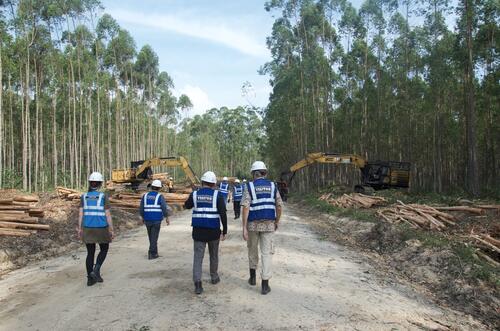
By Alex Weyerhaeuser ’23 MEM, TFD Communications Associate
June 12-16, 2023: The Forests Dialogue (TFD) convened a multistakeholder dialogue under the Tree Plantations in the Landscape (TPL) initiative in Riau, Indonesia. The TPL initiative builds on the Intensively Managed Planted Forests (IMPF) initiative, which ran from 2005 to 2008, during which TFD convened a dialogue in Riau in 2007. This TPL dialogue revisited key environmental, social, and economic concerns raised during the original IMPF dialogue, as well as new challenges and opportunities that have developed in the interim.
Tree plantations currently provide about 35% of the world’s industrial wood supply and are expanding to meet increasing global demand for timber, fiber, and fuel products. The TPL initiative explores plantations’ increasing prevalence and their potential to deliver environmental services and social benefits, including climate change mitigation, ecosystem restoration, and job creation. The dialogue convened approximately 60 Indonesian and international stakeholders, including researchers, NGOs, company executives and rights-holders. TFD convened the dialogue in partnership with Bahtera Alam, World Wildlife Fund (WWF) Indonesia, APRIL, RECOFTC, and the Forest Peoples Program (FPP).
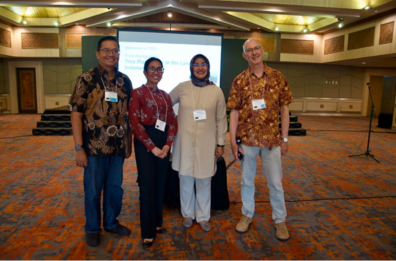
TPL Dialogue Co-Chairs left to right: Aditya Bayunanda, WWF Indonesia director of policy and advocacy; Lucita Jasmin, director of sustainability and external affairs at APRIL; Rulita Wijayaningdyah, Kahutindo; and Marcus Colchester, senior policy advisor at FPP and TFD Steering Committee member.
Participants first spent two days in the field in the Kampar Peninsula, experiencing and learning about a range of dynamics across the landscape including forestry operations (nursery, tree planting and harvesting, high conservation value areas, and water management and greenhouse gas monitoring) and local communities (a community conservation area, an indigenous village, a customary Malay village). “It is fundamental for our participants to go into the field because many have not seen forest management on this scale or in this landscape or haven’t been able to talk directly to community members,” TFD Executive Director, Gary Dunning, explained. “The site visits are really good ways of helping everybody go through a similar experience,” added Marcus Colchester, TFD Steering Committee member and senior policy advisor at FPP. “They see and hear and witness the same things. Of course, they’ll interpret them in different ways, with their own interests and their own priorities, but when they come back to talk about them, they have much more mutual understanding about what’s at stake.” After the field visits, the group then spent two days diving deeper into the key learnings and exploring key issues, or “fracture lines,” as well as potential solutions.
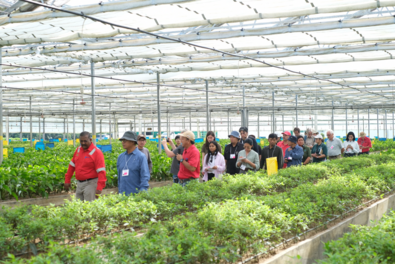
Dialogue participants visit April’s seedling nursery in Kerici.
This dialogue delved into the fracture lines related to the environmental, social and economic costs and benefits associated with tree plantations. Themes included responsible peatland management, sustainable production in the context of jurisdictional approaches, nature-based climate solutions, landscape dynamics, social forestry, and land tenure and dispute resolution models.
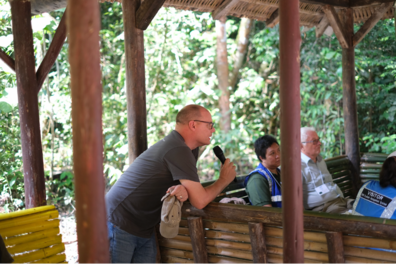
Dunning speaks to the dialogue participants during a site visit to a designated High Conservation Value area.
“Plantations are here to stay and are an important part of many landscapes in Indonesia,” Aditya Bayunanda, CEO of WWF Indonesia, stated. He noted the current intensive management practices and impact on biodiversity and local people: “It’s important to be able to find ways to make sure that these plantations as a whole contribute to the conservation or the protection of the landscapes.” Riau, especially, has seen land converted from natural forests into large-scale tree plantations and agriculture, especially oil palm. This dialogue was important for understanding both the impact plantations have had on the landscape, and the potential they could have for restoration. “We wanted to see the impacts of plantations’ large footprint in this region, where they have done conservation, what kind of mindset they have about sustainability, and the impact of growing Acacia crassicarpa, a non-native species, on peatlands,” Bayunanda explained.
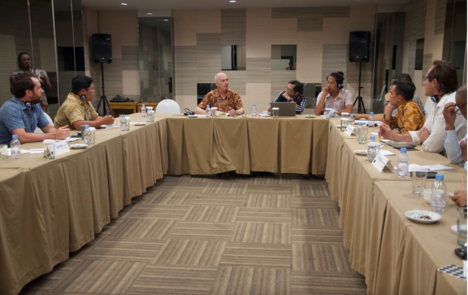
Participants in plenary discussion in the dialogue room.
An important dynamic that has risen to the front of environmental concerns since the IMPF dialogue is the huge role the area’s peatlands play in carbon storage. APRIL Group, one of the world’s largest pulp and paper product manufacturers and a primary land user in the Kampar Peninsula, has 60% of its plantations on peatlands. The company is actively trying to understand the role of tree plantations and water management in carbon emissions, and shared new research showing some forested peatland no longer acting as carbon sinks. Bayunanda cautioned the need for long-term data to look at these trends in both wet and dry years and to put more research into dynamics between native forests and adjacent plantations.
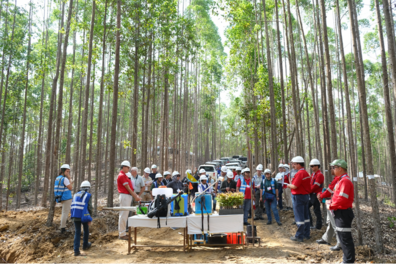
Participants visit a production site on one of April’s forest estates.
“I had mixed feelings when I looked over the landscape because I could imagine that landscape 30 years ago as beautiful, intact forest and it’s sad to see all that conversion into palm oil and tree plantations,” admitted Maurem Alvez, sustainability consultant at Klabin, Brazil’s largest paper production and manufacturing company. “But we also had the opportunity to talk with local communities and have an understanding about their need to have some kind of economic alternative.” She was moved by a smallholder farmer who credited his survival to palm oil. “It brings you a broad view about the real need to balance the social needs and environmental aspects.” Riau represents many of the different land use imperatives on the ground: economic, social, environmental, explained Lucita Jasmin, director of sustainability and external affairs at APRIL. “It’s important to see how these dynamics are playing out.”
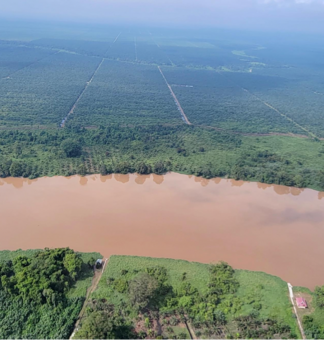
Broad view of land use in Riau.
But these issues are not unique to Riau or even Indonesia. “The deforestation of tropical forests is a global topic,” reminded Francisco Rodríguez, TFD Steering Committee co-lead and certifications and sustainability manager at CMPC, a Chilean forestry company. The issues raised in this dialogue reflect those that have occurred in other global regions with similarly high rates of deforestation, including land tenure and use rights, conflicts between forestry companies and local communities, and habitat and biodiversity loss.
This dialogue created an opportunity for stakeholders in the region to talk and listen to one another, namely staff of forestry and palm oil companies, smallholders, local and indigenous communities, and forestry and conservation groups. “This dialogue was long overdue,” Jasmin admitted, eager to engage and build trust between stakeholders. “TFD has a defined platform where you can have an earnest dialogue where challenges can be raised. It’s not just about one company, but land use in the entire region.” Local indigenous communities enthusiastically joined this dialogue, viewing it as an opportunity to “strengthen the movement in recognition of indigenous peoples, promote indigenous land and forest protection, voice the interests of indigenous peoples, and build networks and collaboration with relevant stakeholders,” explained Harry Oktavian, executive director of the local NGO, Bahtera Alam, representing indigenous rights. Colchester similarly discussed the need for communities themselves to be part of the process and how important it is for people to get a sense of the reality on the ground. In this dialogue, local people sat at the table as equal participants with people from forest companies, conservationists, youth, academics, and international forestry experts. “They are not just rights holders but stakeholders,” Colchester confirmed.
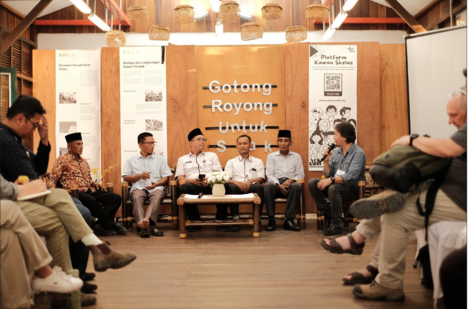
Octavian facilitates a visit to the Customary Village (Kampung Adat) in Kampung Tengah as the group meets with the Chairman of the traditional institution of Siak LAM (Lembaga Adat Melayu) and community representatives.
Participants were tasked with reflecting on how the forestry operations, the landscape, and stakeholder relations have changed since the IMPF dialogue in 2007. Bayunanda reflected on the changes he noticed that have been made on the production side, especially in intensifying production and peatland management, but not so much in biodiversity. Oktavian also voiced continuing conflicts between regional stakeholders, inconsistent implementation of regulations, and limited access to resources and information for indigenous peoples as persisting challenges in the region. “The process of recognizing and protecting indigenous peoples’ customary forests often encounters resistance and rejection from parties with strong economic interests,” he shared.
The field visits provided an opportunity to hear directly from local community members about their connection to the lands and some of their frustrations with private sector actors in the landscape. This experience was emotional for the local community members and surprising for some stakeholders. “When these members of the group took part in the breakout sessions, we understood that these were legitimate concerns and valid perspectives,” Jasmin recalled. “We began thinking: how do we systemically approach this? How do we become much more impactful and effective in terms of first understanding the perspectives of the communities before even coming up with a potential solution? And how do we employ dialogue more in our process, versus formal meetings and negotiations? Just seeing their faces and talking to them was really helpful.”
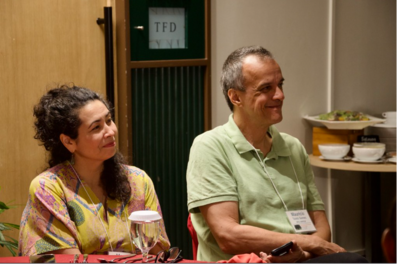
Alves (left) and Mauricio Talebi listen to other dialogue participants during the plenary discussion.
“A door was opened between the different stakeholders,” Rodríguez noticed. “Communities probably felt more open to participate with TFD there and to present how they would like to participate in what is going on in this landscape that is shared between so many different stakeholders.” Colchester acknowledged, too, that there were “quite heartfelt expressions of what harms had been done and what was required to remediate” but that locals seemed willing to continue working with the company. “They weren’t saying ‘go away,’ they were saying ‘let’s do this.’” Bayunanda found hope in the way both parties engaged in this point of contention: as an environmentalist he could imagine how they could remedy the environmental issues, but was always more skeptical about dealing with the complex social tradeoffs. “Trust-building is an ongoing process,” Jasmin concluded. “It’s something that needs to be proactively pursued. You earn trust from stakeholders, it’s not something that can be asked for or imposed. We need to listen more and be out there more, especially those of us based in Jakarta, in the city. When we came out into the field, we realized these are the conversations that need to happen.”
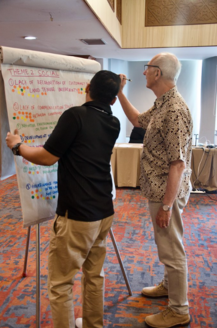
Colchester tallies up a prioritization of social issues exercise during a breakout session.
Of course, many environmental and social issues remain in this landscape, but participants feel hopeful that change is underway. “There is increasing awareness at the level of government and related institutions regarding the importance of recognizing and protecting indigenous peoples and customary forests,” Oktavian noted. “Quite a number of laws and regulations have been issued at the national and local level that regulate the protection of indigenous peoples and customary forests so that they can strengthen their protection efforts.” Another important change was the Forest Stewardship Council’s (FSC) recent policy updates that will provide pathways for companies to “associate” with FSC if they go through social and environmental remediation. “I don’t want to sound too positive, but I see this remediation process that [APRIL] will go through as a big factor in making sure these plantations are generating positive impacts,” Bayunanda reflected. “I actually see from the company that there is willingness to change, to do new things. So coupled with remediation and investment in general protection, I think there is some hope.”
Jasmin confirmed this willingness to listen and change. “A dialogue is still a learning process. It’s not meant to immediately solve a problem or yield an action plan. It’s about being able to listen and arrive at a shared perspective because we’re trying to solve a problem that is not only ours.”
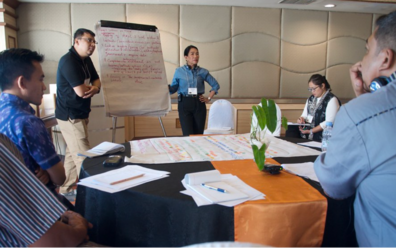
Jasmin leads a breakout discussion with Dedy Nugroho on key themes from the site visits.
TFD looks forward to continued engagement on the work they catalyzed. “There are things that only the local actors can do, but now they have a bit more opportunity to collaborate that may not have existed before,” Dunning explained. “There’s real tangible action that hopefully will be taken.” Local stakeholders remain excited about using this momentum to continue dialogue around these topics in this region.
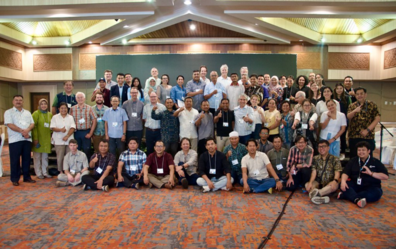
Full group of dialogue participants.
